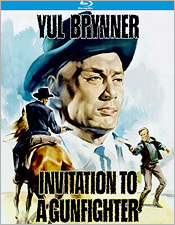Invitation to a Gunfighter (Blu-ray Review)

Director
Richard WilsonRelease Date(s)
1964 (May 26, 2015)Studio(s)
United Artists (Kino Lorber)- Film/Program Grade: B+
- Video Grade: B+
- Audio Grade: B
- Extras Grade: D
Review
With 1964’s Invitation to a Gunfighter, director and co-screenwriter Richard Wilson was setting his ambitions higher than those of the average western. With the imprimatur of Stanley Kramer (Inherit the Wind, Judgment at Nuremberg) as producer, it wasn’t a surprise that the film addressed issues of social injustice and inequality within the familiar framework of a western revenge drama. Invitation has recently arrived on Blu-ray as part of Kino Lorber’s Studio Classics series.
Based on a 1957 teleplay of the same name which originally aired on Playhouse 90, Invitation to a Gunfighter is set in 1865 in the post-Civil War New Mexico Territory. Young George Segal – still in his matinee idol years – stars as the “reb,” Matt Weaver, targeted by the corrupt “boss” of the town, Sam Brewster (Pat Hingle). Brewster envisions bringing Weaver to a quick end when he extends the titular invitation to the deadly gunfighter Jules Gaspard d’Estaing (Yul Brynner). But once d’Estaing gets caught up in the shifting loyalties and allegiances of the frontier town, it’s not long before he lets Brewster know who is really in charge.
The picture, of course, belongs to Yul Brynner. The Tony and Oscar-winning star of The King and I was making a return to the western milieu with Invitation. His portrayal of strong, largely silent Jules Gaspard d’Estaing made full use of Brynner’s steely, intense glare and regal bearing. Befitting the star, Richard Wilson (a onetime associate of Orson Welles) and his co-screenwriter/wife Elizabeth Wilson provide a lengthy build-up to fully introduce d’Estaing’s character in which he exudes quiet danger. As the film progresses, Brynner gets a chance to explore other dimensions of his character. He even sings a bit, showing a more sensitive and even vulnerable side of the cold-blooded contract killer as he strums a guitar or plays the harpsichord. (Composer David Raksin of Laura fame, who offers his share of booming western cues, cleverly incorporates the strains of the harpsichord into his score.) By the time d’Estaing snaps and goes on a shocking rampage through the town, the moment is fully earned by the actor. A climactic confrontation with Hingle illustrates just how dramatically the power has shifted. The specter of slavery looms over Invitation to a Gunfighter, and the film makes its quiet, compelling case for racial harmony in both its revelations about d’Estaing and of the small town’s marginalization of its Mexican population under Brewster’s control.
Janice Rule is well-cast as the pensive, conflicted Ruth. Weaver’s longtime love, who has married another man in his absence, finds herself as object of d’Estaing’s affections. Her steely demeanor melts somewhat as she warms to the enigmatic gunfighter during the course of the deliberately-paced film. Though only 92 minutes long, Invitation lets its story unfold naturally and with numerous moments of silence. It’s slow, but rarely dull. Segal fares well in one of his earliest starring roles; Stanley Kramer was apparently suitably impressed to cast the actor in 1965’s acclaimed Ship of Fools. While Hingle’s character of Brewster is the most one-note, he happily resists the temptation to offer too broad a portrayal of the villain. Cinematographer Joseph MacDonald (The Carpetbaggers, Rio Conchos) makes particularly effective use of shadow and light. Shot on the famous Universal Studios backlot, the look of Invitation is spare, but cinephiles will no doubt enjoy the prominent appearance of the “Psycho House.” In fact, the famous residence of Norman Bates and his mother was actually expanded for its use in Invitation.
Kino Lorber’s 1:66:1, 1080p Blu-ray presentation features crisp, vivid color that serves the movie well. Occasional damage, including speckling and flicker, does mar the print, but on the whole, the image is bright, colorful and true to the filmmakers’ intentions with grain intact. The 2.0 DTS-MA track is rather less impressive, though it’s adequate for dialogue, music and effects. English subtitles are included. The film’s original trailer, however, is the only bonus feature.
Invitation to a Gunfighter elevates the standard-issue western thanks to its ambitious themes and the performances of a uniformly fine and committed cast of veteran actors and future veterans. Fans of the film as well as those looking for a slightly off-the-beaten-path western would be well-served to check out Kino Lorber’s new Blu-ray release.
- Joe Marchese

